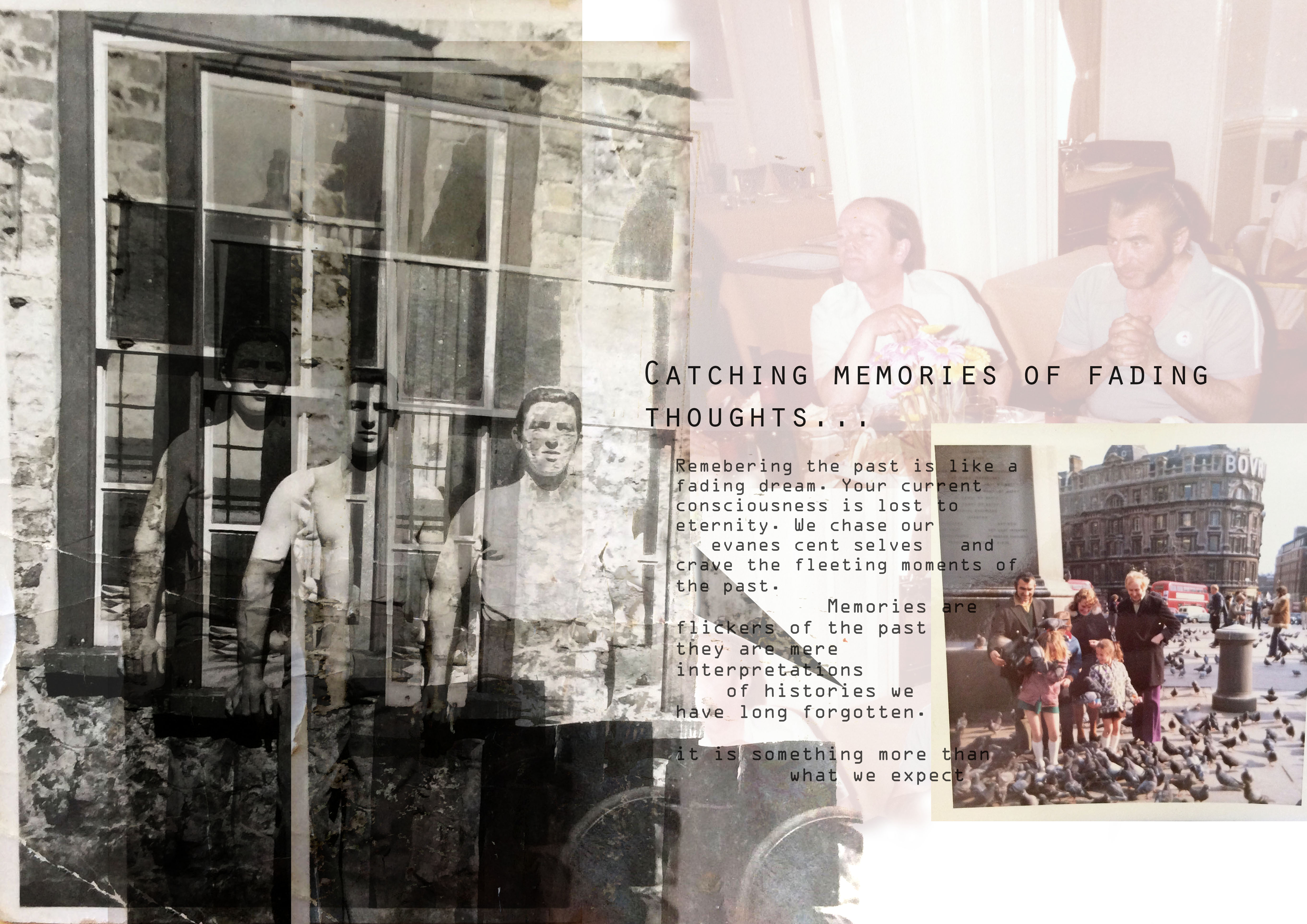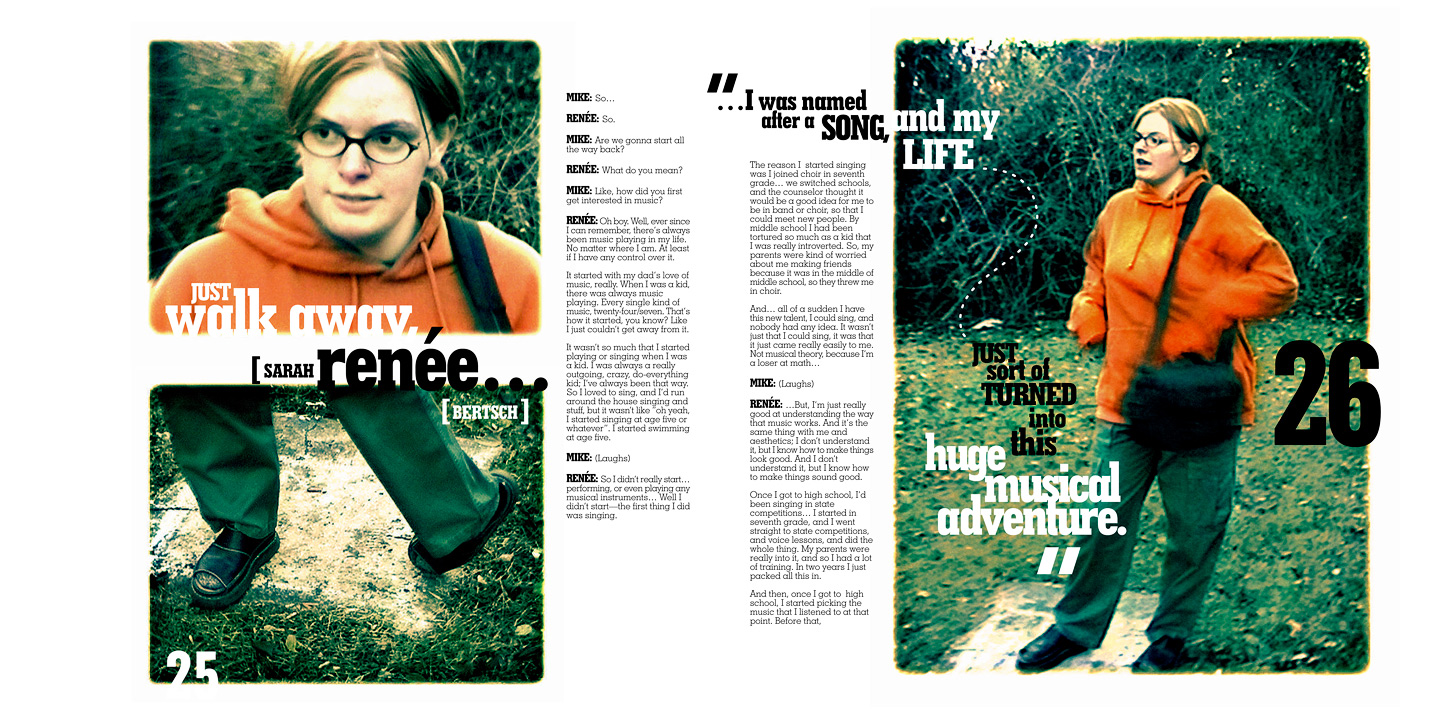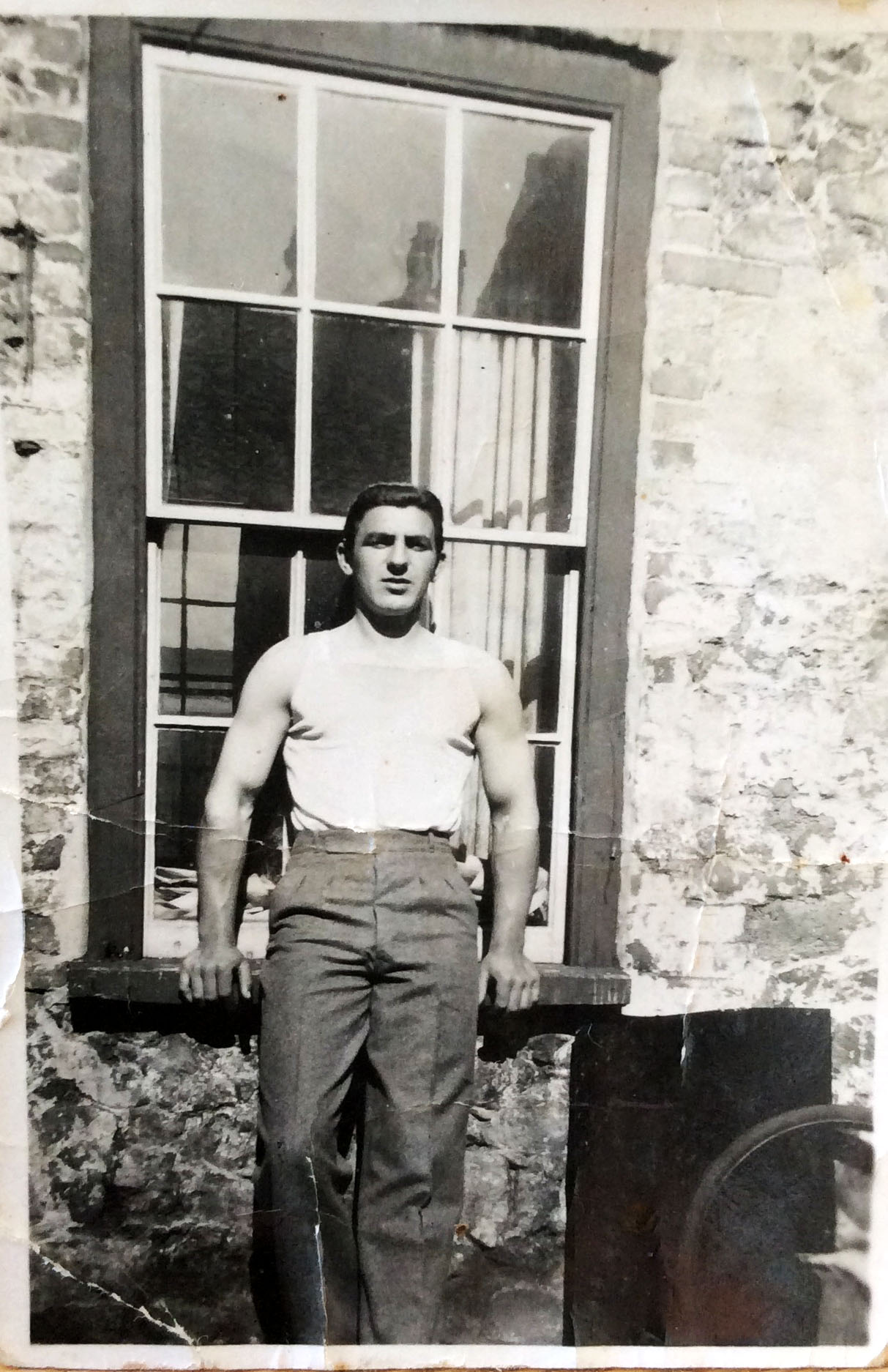This is my second picture story design, I have used both archival images that I have collected from my mother’s albums and created new photographs from personal items such as condolence letters, newspaper prints and albums. Furthermore, I scanned images such as my grandfather’s passport because I thought this was an extremely interesting personal item. It held his identity and was a crucial belonging he carried around with him his whole life, therefore it had historical meaning and heritage. I included the main title ‘Three Chapters’ as well as the subtitle ‘Ten years have passed but it still feels like yesterday.’ Moreover, I included a quote from a close family friend that they wrote in a condolence card. I wanted this picture story to be clean and professional which reflected the main idea of project.
All posts by Holly Benning
Filters
Headline, text, caption
Headline, text and caption
For the text in this picture-story I wanted to explore what people thought of memories and their interpretations of these invisible sentiments. However, when I was researching I found it to be very difficult to find what people thought memories actually were. Most of the information I found was very scientific which is not the sort of thing I wanted for this particular project. I wanted the piece to be a poetic picture-story therefore the words I used needed to reflect this. So in order for the concept to work I decided to ask my family’s ideas of what memories are, what we need them for, what they are made from and whether they exist at all. I wanted to take a philosophical approach to this area of work because I think specific philosophers have some insightful ideas for example Sartre.
The headline for the picture-story is also very poetic. I wanted the title to explain everything about the picture-story as well as not giving anything away.
What is a memory? What do you think our memories made up of and why do we have it? Does everyone have a memory? Can our memories deceive us? Are they reliable?
Due to my first picture story being very poetic and artistic because I wanted it to reflect the haziness of the memories of my grandfather therefore, it was important the photographs almost merged together. The only image that is slightly separate in comparison to the others is the archival image on the bottom right hand side, because it is a memory of my mother, it made it realistic and truthful listening to her remember it so vividly. Therefore, the second picture story is more simplistic and only focusing on the images singularly rather than looking at them as a merged sort of collection.
Photo-shop: creating a picture-story
The stages of creating my picture-story:
Firstly, I opened a new page of photo-shop, which needed to be size A3 and was international paper. Next, I selected the archival images I wanted to use and adjusted them so that I could see which designs looked best. I wanted to have a combination of black and white images as well as coloured images too. I decided my establishing shot to be the only photograph I have of my grandfather on his own because I found it fitting for it to be the main image which an audience looks at first.
After experimenting with the more traditional style of picture-story, I decided I wanted to take a more contemporary modern approach. I think the theme of my project being memories means the design needs to reflect it in order for it to work well. I took inspiration from one of the magazine spreads I found on the internet. I thought it was very imaginative and creative which is what I want my picture-story to portray. I overlayed the images of my grandfather because I have so many memories of him and he has lots of different aspects of him which I want to show in my study. This will be the establishing shot and the title will go in the top right corner so that they correspond. I think I want to experiment with having snap shots of family moments down the right side. But I will also produce a second versions of this picture-story however, instead I want to put more focus on the photographs I have taken now. I want the flower image to be the background which I will use the opacity tool to change the intensity.
Inspiration: These are some examples of picture-stories I found on the internet. They are magazine spreads and are very contemporary which is the style I want to experiment with. My favourite is the second one, I like the theme of it and the way it has been designed. It goes very well with the theme of memories and the past. Plus it has writing on the right and the photograph on the left of the page which is what I wanted.
Photographs for the JEP Exhibtion
Photographs for the JEP Exhibition
These are the photographs I am entering into the JEP exhibition at the Jersey Museum. There will be Channel 103, Channel T.V and lots of members of the school at the event.
This is one of the main photographs in my picture-story because it is a portraiture shot of my grandfather, there are not many images of him on his own. I think it shows off his personality massively, he was a very strong and brave individual who fought in the war and raised eight children. I like the texture of the image and how it looks old and vintage. There are creases through the middle of the photograph and it is slightly discoloured around the edges but I think this adds to its style.
This is one of my favourite images from all the photographs from the albums, I think the the way the man is just sitting reading his paper makes everything look very casual and everyday. The black and white style is also representing the time period the photograph was taken in, as my grandfather did not have the money to afford photographs in colour.
Analysis of picture-stories
Picture-Story Planning
Photography Notes:
How are images being used in the media and social websites? How are they being used? Why are they in the sizes they are? Minor and major images, detail shots, landscape and portrait shots. How does the title relate to the images? You need to write a text with correlates to the photography. Life magazine- America- 1948- 11 pages. Newspapers are getting smaller and smaller because of the competition with the internet. Restrict it to a two page spread. Digital media and film cinema is bombarded, illustrated magazines aren’t as popular. Online websites- magnumphotos- agencies of photographers. Magnum photos is the oldest and most photography agency. How do you analyse and deconstruct a picture story?
The picture story- visual storytelling through the construction of a traditional picture story. No picture story is ever the same, even if the subjects are identical. There is no one way for a picture story to look, one must be creative. Image and text cohesion offers a perfect way to learn why some pictures work and why some stories are clearer than others.
Picture story examples are from the JEP because it is something we can relate to, we live on the island and we know what’s going on therefore it is easier to discuss. You need the contexts of an image, lens like a wide angle have been used to include the background in order to give extra information. When you make the portraits you have to be creative with the environment you are working in. How can I use the environment I am in? Think about depth of field, think about lens like telephoto lens, and think about the technicalities. Photography is a language and you must know the linguistics to understand photography. Wide angle lens create a very wide depth of field, it gives you definition, it gives you space in a photograph. Can you see who the person is? Can you see what the person is doing? Does the photograph include contexts in order to translate the necessary information? Observe your subject, talk to your subject, and shoot a number of different frames. Shutter speed will help tell the story, gives a sense of texture, and makes the image more interesting.
People at work shot. Relationship shot. Establishing shot- most important element in the picture story because it serves to define the context in which the other pictures have been located. What is the photographer trying to show? What technicalities are being implemented in order to demonstrate the narrative? Your eyes are always drawn to the brightest thing. Adjust depth of field, height, involve yourself in with the environment and subjects. You can have more than one establishing shot. Detail shot- little extra layer or texture to the story.
Portraits are an essential part of the story. They convey a sense of personality and humanity to a story which helps the viewer to identity with the subject. Formal portraits- totally under your control. You take control of lighting, posture, distance, etc. Environmental portrait. Portraits can link with history- for example portrait of Remembrance Day. Observed Portrait. A Local Story- A Place.
I chose this example of a picture-story because it gives an example of a portrait shot as well as an establishing shot. Clearly it is the only image in the magazine but it is a clear representation of a particular style of photograph which can be used in a picture-story.
This picture-story has an establishing shot on the left page which takes over the entire page therefore is the main image. On the right page there is a detail and environmental shot. The detail shot is typically a close up shot which allows for the photographer to give intricate and precise details about the narrative. The environmental shot helps the audience understand the context of the story for example the background information.
This picture story has a variety of different styled shots in order to formulate an interesting and inviting magazine article. The establishing shot is on the left page and is the biggest image. Whereas the smaller images are either detail shots, portraits or environmental shots.
Community- Record
This collection of photographs range from the actual day of the battle to the revealing of the floats. All eight of my grandfather’s children participated in the event, because not only was it a community event but also a family one. Lots of families use to get involved with the battle creating their very own little creative floats.
These are a selection of photographs I have from my family’s albums of the Battle of Flowers. As previously said in another post, my mother’s family regularly took part in the annual event, making smaller floats in their gardens. I thought it would be interesting to include photographs like these in my picture-story because it can represent a time in the battle’s history but also my family’s too. I think it’s really special having my family members in the photographs because they symbolise hundreds of memories and share a part of the art with reality.
Jersey Museum Exhibition
Jersey Museum Exhibition- Analysis of favourite and least favourite photographs
I have chosen this as one of my favourite photographs because I like portraiture photography, especially this black and white style. It has a very ‘poppy’ ‘rockstarry’ feel to the image, also the policeman’s hat being in the image connotes to the idea of trouble and control. This feeling is highlighted by the possibly fans asking for autographs which has been captured at the bottom of the image. The reflection in the subject’s sunglasses also makes the audience focus on this area of the photograph. Moreover, I like the framing of the image because the main focal point is in the centre of the image and the complimentary subjects are there as an additional. I do not think this image would of worked as well if it hadn’t been in black and white. This photograph doesn’t looked as though it were staged, it’s more a documentary photograph where it has been captured for the news or in this case for the JEP Newspaper.
This is my second favourite image because I think it has a very natural feeling to it; the simplicity of the photograph is what makes it interesting for me. Also the position they are both in gives the image a sense of unity and support. Through the subjects linking arms they have created a warm and endearing photograph which could connote to their love for one another. Framing is also very important for this image, having the subjects at the right makes it almost formal and as though it were set up. It is also clever how the photographer has included parts of the plane in order to relate to whatever news story was being published.
My least favourite photographers were of subjects creating the newspapers in the factories. I thought there were too many of this type of image because they didn’t actually have much relevance to the specific project. Furthermore we were not told any of the photographers that took the images, which I found very strange as this could of potentially been a research point for us to begin from.
Vernacular Photography
What is vernacular photography?
Vernacular photography is the creation of photographs usually by amateur or unknown photographers both professional and amateur who take everyday life and common things as subjects. Closely linked to vernacular photography is found photography, which refers to the recovery of a lost or discarded vernacular photograph or snapshot. Found photographs can be found at carboots, charity shops or hidden away in attics. I decided to research this particular genre of photography because a great of the images I have previously posted have been amateur photography which is vernacular style. This photography is very hard for those that are professionally trained photographers. I think this is a really interesting genre because it lets you capture photographs in reality because life isn’t perfectly framed or focused; there are mistakes and distorted shapes and angles therefore it reflects the complications of life perfectly especially in relation to family and community.
How can I incorporate vernacular photography into my work?
Particular photographs I am planning on taking are defiantly going to be in this style. I want to incorporate this style with the theme I am focusing on, with regards to my family project vernacular photography will be the perfect style to highlight the feelings and thoughts of my grandfather. Most of my family photographs which I have posted previously on the blog are vernacular photography.
Community- Jersey Battle of Flowers
Jersey Battle of Flowers
In celebration of the Coronation of King Edward VII and Queen Alexandra the island of Jersey decided to stage a parade. The event that was held on August 9th 1902 was so successful that organisers decided ti repeat it the following year- a summer tradition was born that is carried on till this very day. During the early days of the event, the floral floats were mainly horse-drawn. The tradition at that time was for flowers and petals to be torn from the float and thrown to a lady in the crowd, in the hope that one might be thrown back. This is how the battle got it’s name.
There has only been two periods throughout the battle’s history when world events forced its cancellation, these being during World War I when the parade was abandoned and not restarted until 1926. Similarly, during the Second World War and Occupation of the Channel Islands the Battle of Flowers was suspended. It was much later in the 1950s when a group of local businessmen decided the Battle of Flowers needed to be brought back as a much needed focus for the community as well as the benefit for the island’s tourism sector. The tradition of throwing the flowers from the floats stopped in 1964, although, the name has stuck and has continued to flourish. The parade has continued non disturbed, welcoming an excess of one million spectators over the years.
The Battle has always and will continue hopefully to be a sense of community, commitment and pride. However, the friendly competition between floats remains fiercely strong. As the battle has grown and developed over time as too has the floats in both size and design. Nowadays, floats can reach 45 foot in length and horses have been replaced by hidden motorised machinery to drive the floats along the avenue.
In 1989 in order to enhance the carnival atmosphere even more, the Moonlight Parade. This event is very similar to the day time one, although the floats are illuminated. It is one of the island’s biggest community events involving hundreds of volunteers from across the island. I think this tradition is extremely important for the island in order to share a memory that has lived for years. The spectacular event is community driven, without the residents of Jersey there would be no parade.
I choose to focus on this idea for community because I am able to tie in lots of different aspects for example, my grandfather, who I have focused the family themed project on, use to participate in the parade with his eight children and wife many years ago. I also think it would be interesting to include some archival images as I am sure an event of this magnitude for the the island must have a selection of photographs. From looking at my grandfather’s photographs and talking to my grandmother, I think the battle came across as being a great deal more focused on smaller family groups. Whereas today it’s mainly groups or businesses making larger floats in comparison, which has both negative and positive impacts.





























